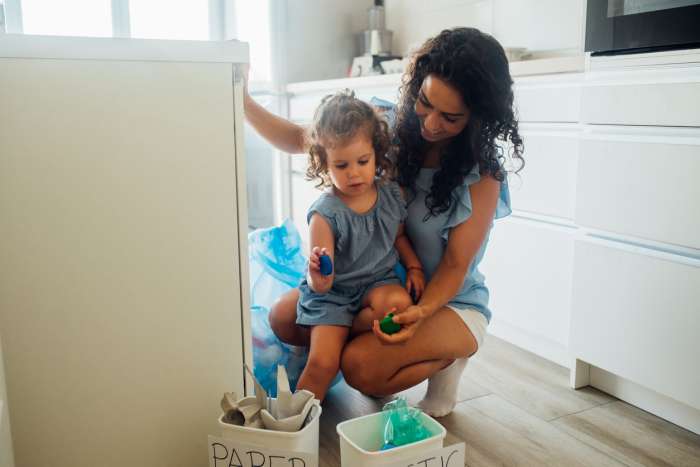Mom life gets hectic. When you feel like you're always picking up toys, doing laundry, running to the store for more clothes, school, supplies, food, etc. it’s easy for moms to feel stressed and overwhelmed.
Many moms are turning to minimalism as a way to feel more at peace and prioritize the things that really matter for their family. But what does minimalist parenting really look like?
Related: A Minimalist Approach to All of the Baby "Stuff You Need" On Your Registry
What is Minimalism?
The word minimalism may bring to mind a totally empty, gleaming white home and a set of stern rules where Marie Kondo forces your to throw away 90% of everything you own. But that’s not minimalism at all!
Minimalism is a lifestyle that encourages anyone to be more mindful about how they spend their time and money. Minimalist moms focus on making intentional choices for their kids and family every day.
Incorporating minimalism in your life and living in a minimalist home means de-cluttering both your physical space and your mind. It’s being intentional in how you spend time together and prioritizing making moments over spending money.
10 Ways to Help Your Kid Get Organized for the New School Year
Developing good organizational skills is a key ingredient for success in school and in life. Read More
When you practice minimalism, you’re noticing that it’s easier to simplify your family’s routines, you find yourself being more mindful as a parent and feeling less stress, and you’re developing stronger relationships with your family.
How to Become a Minimalist Family
As you learn more about minimalism and start to implement those learnings in your own home, you’re realizing that inviting your children to join the process will help everyone’s well-being in the long run.
But where do you even begin teaching your children the benefits of minimalism? In this article, you’ll learn many different approaches to teaching minimalism to kids. Take what works for you and invite your children to add their own perspective to your family minimalism approach.
Explain the Benefits of Minimalism
The easiest way to teach minimalism to kids is to explain to them why you’re doing this, and how it will benefit your family.
Kids can feel when their parents are stressed out and they want their home to be a happy and relaxed space as much as you do! See if you can encourage kids to be mindful through things like deep breathing activities, taking long walks in nature with mom or dad, or closing their eyes and listening to a favorite song.

Encouraging mindfulness in kids early can help them regulate their own emotions, anxiety or anger and feel better both physically and mentally. Start small and tell them that living a minimalist lifestyle allows your family to prioritize experiences and focus on what it is that truly brings you all joy.
How you talk about minimalism will definitely depend on their age and how attached they are to their belongings. You can explain that when your home is clean and organized, it’s so much easier for mom and dad to plan more fun family time activities.
Children may be moved to downsize if they see that they’ll be spending less time cleaning up after themselves or have less choices to make. For example, getting dressed in the morning is a lot easier when they have less clothing to sift through.
And the more extra stuff that you buy, the more time it takes to put things away. It’s easy math: Less time cleaning up = more time playing!
Make Your Home Minimalist and Live By Example
Your children are constantly watching and learning from you. Which is why the easiest way to teach minimalism to kids is through living the example yourself. Your children will notice your enthusiasm and their interest will grow, too.
Let your children see you declutter small spaces at a time. If you’ve already explained minimalism to your children, there’s no need to make a big deal about what you’re doing. Simply pull out the junk drawer and downsize while you watch a television show together. Seeing decluttering and downsizing happen in a routine manner will normalize the efforts for your children.
Teach Kids to Downsize and Declutter
Begin a conversation about what you’re doing. For example, you could explain why you’re choosing to give some items away and throw out others. You could explain the benefits of donating and talk about who will get the items when you’re done with them and how they will use them.
This is especially helpful if they are donating toys to a younger family member or family friend, as they’ll be able to visualize that child playing with their toys, instead of wondering what happens to them when the toys leave the house.
Praise a Clutter-Free Space
Showing kids how to practice minimalism in their own lives is the best way to demonstrate the power of this lifestyle. When you allow them to have agency over their efforts, they’ll feel more invested in decluttering their own living space and getting rid of excess possessions.
First, start by teaching them how to sort through small spaces or types of belongings so they don’t feel too overwhelmed doing this on their own. Aim for small wins, such as throwing out broken belongings or extremely old drawings and crafts. Remember to always celebrate small wins.
Your first effort at involving your kids might end here temporarily. Praise them for their efforts and remark on how nice their space is with those items removed.
Empower Kids by Giving Away Things to Help Others

Focus on donations in your next attempt at decluttering and downsizing. If you’re able, start with belongings they have less attachment to, such as your kids clothes. The quick wins would be to remove all the clothing that no longer fits them. Don’t forget to include shoes, socks, underwear, pajamas and outerwear that no longer fit, too!
After you’ve removed the too-small items of kids clothes from their spaces, encourage your children to look at what they saved. Are their articles of clothing that they like less than the others?
They may have outgrown outfits with characters on them or find themselves avoiding certain colors or patterns when they get dressed. If your child appears motivated by the minimalism process, these items would be great to donate as well before taking another break.
Make Decluttering a Reward Not a Chore
Remind your children that less clothing means less laundry to do and put away too. Constantly showing them the benefits of a simple life with less stuff and less stress will reinforce the idea that a minimalist lifestyle is right for your family.
You can also praise decluttering and downsizing as a way that your kids are growing up and becoming more independent! By getting rid of the toys, clothes and home decor they liked when they were younger, they’re now entering a new, more mature phase of their life.
When you’re ready to begin again, practice that same effort of removing belongings that no longer “fit” out of your children’s space, and then removing the items they no longer have interest in.
An example could be to remove baby and pre-school level books from an elementary school children’s room — with permission, of course so they feel autonomy over the changes in their environment — and then follow up by removing the books that no longer keep their interest.
Encourage Mindful Consumption
Now that you’re involving your children in downsizing their belongings, it’s also just as important to talk with them about being sure that more (and more!) doesn’t find its way back into the house now that there is space. Explain to them how minimalism helps to create a more sustainable lifestyle and is better for the environment.
Now, look at what toys your children have kept. Are the kids toys encouraging open-ended play or imaginative thinking?
Encourage your kids by sharing different scenarios or ways they could play with their toys that they might not have thought of before. For example, stuffed animals can attend tea parties, go camping under the dining room table, perform in dance parties, and so much more.
Communicate Your Minimalist Lifestyle to Other Family Members
It is important to address the elephant in the room: Other people. Your children are constantly being bombarded with things. School is sending home worksheets, artwork, and notes from the administration. They’re likely to get favor gift bags at birthday parties or knick-knacks from clubs and other activities.
While you can’t control everything other people do, there are some ways you can help the other adults in your kids’ lives to embrace aspects of a minimalist lifestyle.

Encourage Giving Kids Less Gifts and More Memories
And let’s not forget the grandparents! They love to spoil their grandchildren, and so do many other family members and friends. It’s important to have an explicit conversation with the people in your children’s lives about what your expectations are in regard to presents. Set boundaries with grandparents and communicate them clearly.
If they insist on physical gifts, let them know you prefer items that are made from quality materials that can last for years, or items that encourage your child to be creative or use their imagination.
In an interview for this article, Caroline Roberts, professional organizer and founder of “The Simplified Island,” says, “It can be difficult to make decisions different from what we've always known or that go against what we hear from others, so be open to gently setting boundaries and having tough conversations with loved ones as they wrap their brains around your new way of living.”
Prioritize Family Experiences Over Items
Roberts says, “My goal when working with clients both in one-on-one services and through my programs is to reduce the number of belongings they have, because less stuff almost always means more free time.”
And more free time means more opportunities to experience life together with your children. If you’re not constantly cleaning or and your children are not constantly distracted by an immense amount of belongings, you’re all able to get out and experience life together.
Get Outside and Spend Family Time in Nature
Draw them into the conversation by asking them what they’d like to learn or do with you. For example, you might try out hiking and geocaching or taking a crafting class together.
You could occupy your time by joining clubs or signing your children up for sports teams. The possibilities are endless, and by involving your children in the experience planning, they’ll have something to work toward and look forward to.

Understand and Honor Your Family Values
As you read these suggestions and begin to choose which will work best for you and your kids, know that there’s no “right” way to approach minimalism. Roberts says, “We get information and ‘best practices’ from our family, friends, influencers, parenting experts, and even random people in the grocery store.
The most important, and sometimes most difficult, part of decluttering and minimizing is to block out all those voices and get real with how you want to live and raise your children.”
She continues and asks, “What are your family values? What are your short-term and long-term goals? How do you want to spend your family time?”
Your personal answers to those questions will be the best guide in how to approach this in your own minimalist family. But don’t forget to involve your children if they’re old enough.
If they’re invited in to join the conversation, you may be surprised about just how on-board they are with decreasing their belongings so they can live with less clutter and lead a more meaningful life.
And finally, remember that a minimalist way of life is a process and not a sprint. The Minimalist Vegan reports that “For most families, it takes 1-2 years to transition to a minimalist lifestyle.” So take your time, work together, and enjoy the process!
For more minimalist parenting tips check out our guide to How to Have a Minimalist Christmas with Kids!



